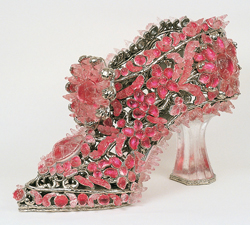Conservation Department
Object conservation
introduction | essay | objects | paintings | paper | prevention | textiles
 Tim Horn 'Glass slipper (Ugly Blister)' 2001, lead crystal, nickel-plated bronze, Easter egg foil, silicon, Collection of the National gallery of Australia more detail
Tim Horn 'Glass slipper (Ugly Blister)' 2001, lead crystal, nickel-plated bronze, Easter egg foil, silicon, Collection of the National gallery of Australia more detail Objects conservators at the National Gallery of Australia are responsible for the care and maintenance of all 3D objects in the Collection, including the sculptures in the Sculpture garden. Unlike other sections in the Conservation department, objects conservators look after objects made from a diverse range of inorganic materials, such as stone, metal, glass and ceramics, as well as organic materials of plant, animal and synthetic origin.
The work undertaken in this section involves the examination and treatment of objects that are required for Gallery exhibitions, travelling exhibitions and loans to other institutions. Thorough examination, photography and documentation of each object is carried out prior to any treatment, in order to establish a comprehensive record of its condition.
The simplest and most routine treatment that an object requires is cleaning. Surface dust is usually removed with a brush and low vacuum suction. Ingrained dirt in an object’s surface can be cleaned either by using cotton swabs and solvents, or by poulticing. The wide range of materials that 3D works of art are made from precludes the use of standard treatments. There are, however, some treatments that are carried more frequently than others, such as the consolidation of the paint layer on a bark painting, or an adhesive repair on a broken or cracked object.
Even standard treatments need to be carried out with care and vigilance as slight changes in the composition or make up of a material can lead to vastly different results for an identical treatment. In this context the repair of the Ambum stone, a key work in the collection, is a good example of a complex and difficult conservation treatment that was undertaken in 2000.
The objects conservation team is committed to undertaking research into and analysis of works of art and materials in the collection. Recent projects have included:
• Materials analysis and ageing of materials used in Ron Mueck’s Pregnant woman.
• An investigation of the properties of paperclay to determine its use as a repair material for earthenware ceramics.
• Field studies on current materials and techniques used in Aboriginal bark paintings and in-depth analyses of the individual materials used in their manufacture.
Related articles
Can good girls go bad? Preliminary studies on ageing characteristics of materials used in
Ron Mueck’s Pregnant woman
Conservation in the Sculpture garden
Conserving Aboriginal bark paintings Beata Tworek-Matuszkiewicz artonview 38 winter 2004 pp.44–45
The Standing adorned Buddha artonview 34 winter 2003 pp.32–33
The Ambum stone: object treatment
preventative conservation
plastics
bronze
more links
loans
poulticing
paperclay
